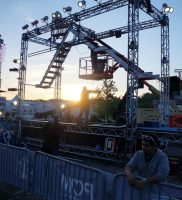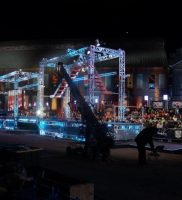
Inside the abandoned Blast Furnace, or scenes from “America Ninja Warrior” (Vice)
Just outside of a 108-year-old blast furnace, near the start of the American Ninja Warrior course, someone is hanging nonchalantly from an arch made of trusses. Occasionally he breaks up the dangling by gliding hand over hand a few feet to one side or the other. He’s impressively lackadaisical about all of this, and stares out toward the bleachers as he moves himself through space. It’s hard to tell if he’s a ninja, honestly. He may just be someone who felt like climbing on something.
There is a lot of this, because there are trusses everywhere. They are the building block for the series of enormous, increasingly outlandish obstacles, but they’re also askew on the ground, rigging what must be hundreds of lights, and framing the giant branded crests that blot the landscape. This particular arch might have been provided for the athletes to warm up on, or it may have been reclaimed by the people. The latter would not be surprising. Either is possible.
Read More: American Ninja Warrior Is What Sports Should Be
This is all absurd, top to bottom, but that is “American Ninja Warrior.” Everything outside of the actual athletics is a carefully manufactured reality competition, done with the lockstep discipline you’d expect from a network television production. Everything that is not the TV show—the actual athletic contest that is, more or less, scrambling through this sadistic course as quickly as possible—is astounding.
These are adults living out every childhood playground/family entertainment center/freestyle-running fantasy, albeit in the most brutal and public way. For all its loud n’ flashy television wrapping, the obstacle course spectacle of “American Ninja Warrior” is a simple thing at its core. This is jumping from the recliner to the couch because the floor is lava, but with that fundamental principle rendered huge and awesome and so damn difficult. At a primal level, “American Ninja Warrior” is about every time anyone ever slid down a banister when they could have used the stairs. It’s doing a wheelie in your wheelchair. It’s wedging the toe of your shoe into the diamonds of the chain link and climbing over instead of walking around. It is doing something difficult for no good reason beyond that it is 1) difficult and 2) fun, in that way.
Also, it’s a chance to compete for a million dollars at better-than-lottery odds. But the reality is that for all but the best of these competitors—all of them incredible, even the ones that only get a few seconds of televised faceplanting—that’s not feasible. It’s a chance to do things that grown people don’t always get the opportunity to do, to see something wild on television, say “I can do that,” and then go out and try it. If you’re good or lucky, it’s a chance to be on TV yourself, and bring your people along for the ride. Mostly, it is a chance to climb on an extremely cool swing-set, and see who on the playground can go the farthest. All of which is kind of a long way of saying that all this silly stuff is not just a sport, but something like the spirit of sports in action. So that’s what we were all watching, next to the decommissioned blast furnace near Pittsburgh.
The bulk of Carrie Furnace, which mostly no longer exists, sits just southeast of the city in the boroughs of Rankin and Swissvale, on the north bank of the Monongahela river. For decades Carrie churned out tons of iron for the Homestead Steel Works, first under Andrew Carnegie and then as part of U.S. Steel. Penned in by train tracks and water, it’s accessible through a narrow stretch of potholes that might only generously be called a road. This is where the Pittsburgh regionals are being contested—and more relevant to the aesthetics, where they will be filmed.
Carrie Furnaces 6 and 7 were constructed in 1907, and operated until 1978. Today, the pair of 92-foot tall towers and several dilapidated support structures are all that’s left of the facility. They survived the bloody Homestead Steel Strike—where despite being publicly pro-labor, Carnegie sanctioned the stomping of his workforce—and the later industrial downturn, the eventual abandonment of the plant, and the continued environmental fallout. In 2006, they were eventually tagged a National Historic Landmark. There are ongoing plans to preserve and repurpose the site.
In their current zombified state, the furnaces are both beautiful and unsettling. They’re a hulking memorial to human ingenuity and Midwest decay cast in rust and crumbling brick. It’s a setting that has inspired art of all kinds, from gorgeous photography to a gargantuan deer head sculpture. The Appalachian grimecore epic Out of the Furnace—a strong contender for Film In Which Christian Bale Has Looked Unhealthiest honors—filmed here. This weekend, from dusk until dawn, the place will be lit up like an upbeat haunted house, and will serve as a backdrop for a weird love poem to human locomotion.
It’s still daylight, Friday evening. The only audience is an ad hoc collection of crew, course-testers, and whoever else happens to be wandering around this early. There is no GONG! sound effect booming over the PA when a run starts and there are no smoke machines.
The testers do not care much about any of this because this is a chance, too. Forget that it’s not official and that no one is recording their runs. Ignore the stagehands swarming with poles, impact wrenches, and belts adorned with bouquets of zip ties. None of that has much bearing on the fundamental transaction occurring between athlete and obstacle and whoever is lucky enough to be around to watch.
Whenever a tester clears a section and reaches the landing platform, the makeshift crowd gives a little cheer. Even if they are the only ones watching, they know what they’ve just seen.
Later, the first wave of athletes are given a walkthrough of the course. A bearded crew member in a hoodie stands above them with a megaphone, reading the rules for each obstacle from a script. At the appropriate time a beautiful shirtless man gives a demonstration of something called the Devil Steps, gripping the edges of a series of ascending and then descending platforms. His hair remains perfect throughout. Several hours from now, when the temperature is down to 52 degrees and dropping, he will still not have a shirt on. This doesn’t even seem unreasonable.
The contestants have questions and the man with the megaphone fields them, rapid fire. Some are looking for some comfort regarding what they will be facing. Others are looking for an angle to beat the system. When they are done with each obstacle, the crowd of ninjas is filmed raising their hands to acknowledge they’ve been given the rules.
In addition to the rules, the production crew conveys other helpful information. Some of this is practical: “Don’t back up too far and burn yourself on this jet heater,” and “Please don’t do a flip over this safety rail. It’s a safety rail. Go around it.” Some of it is theatrical: “Celebrate! Let America feel your pleasure and your joy.” Those first two quotes are paraphrased. The third is verbatim.
“American Ninja Warrior” competitors come in a variety of shapes and sizes, but the best tend to be compact, extremely fit men and women; they favor a variety of lycra and flamboyant socks, conspicuously devoid of logos. Continuing the tradition of the show’s original Japanese incarnation, some of them will run in costumes, generally representing something about their Character. On TV, you will note that the Boy Scout is in uniform, the stuntwoman is dressed as a chicken, the bond trader is wearing office-appropriate pants.
In Pittsburgh, it’s not entirely sure what the grown man in a diaper, bonnet, and black swashbuckling mask is representing. I also see a set of legitimate looking Harlem Globetrotter warm-ups, a nurse in scrubs, some sort of Jedi, a brave soul dressed like a liberal arts professor who may be running the course in khakis, and a burly treestump of a man in fire department gear. It’s preordained that almost all of these people will fall before finishing the course.
Every fall is different. Some are as innocuous as a limb brushing the water. More often, a steady stream of men and women tumble and splash dramatically into one of the pools situated below the obstacles. In the worst cases, there are unpleasant-looking collisions, loud hard thumps into surfaces that are only sometimes padded. There will be finishers during this first stage, of course, but most runs will end with the crowd gasping, and then groaning as the course’s lighting shifts to red. The final television cut will be the product of heavy sound editing. But there’s plenty of it happening live.
Doom is being plastered to a cylinder in the middle of the Wind Chimes, embracing it desperately while gravity does its thing inch by inch. You are too good at this to just let go and drop, but your limbs are exhausted and will not get you to the next pylon. So, you hug a vertical tube and you wait for the inevitable while the crowd chants your name. They know you are doomed, too. Everyone knows. They chant anyway. You try everything you can, which doesn’t amount to much. Finally, you fall. It’s all right; most everyone falls. You fall well. You re-emerge into the world as an ex-competitor, soaking wet.
It should come as no surprise that the kids are the best part. The friends, family and fans of the ninjas rotating through the stands are of every age, but there is an abundance of wide-eyed children. When the crowd is implored to get hyped so the crew can shoot some b-roll reactions, the kids go all out. When textiles are lobbed into the stands they scramble frantically. They don’t care if these are t-shirts, or Terrible Towels, or whatever branded swag the sponsoring pomegranate-juice company is distributing, they just want to catch something.
A kid behind the stands, craning his neck, implores his dad: “Where’s the Warped Wall, again? I can’t see the Warped Wall.” His dad lifts him up onto his shoulders for a better vantage point, and he proceeds to explain to his father exactly where the wall is in detail. Ten seconds later he is shouting “Daddy, put me down!” One toddler wanders past and announces “I need to go-to-the baaaaaaathrooooooooom,” and then turns and smiles at me, letting me know he was laying it on thick. A girl does not want to stop to take a picture in front of a banner but her mom convinces her that it is once in a lifetime, and she eventually smiles anyway.
Between takes, the announcers—the former NFL lineman Akbar Gbaja-Biamila and Matt Iseman—come down from the tower and pull kids out of the crowd to take pictures. This is exactly as adorable as you would imagine.
Who better to enjoy this than children? Children understand what this kind of not-strictly-necessary jumping and running and climbing is all about; it is something like the default behavior and belief system of all three-year-olds. Children like to cheer, and wear supportive matching shirts, and wave things like homemade light sabers. In a crowd of people enjoying themselves, the kids are clearly enjoying themselves the most.
They take the falls to heart. They relish each individual obstacle conquered. When someone approaches the final obstacle, they cheer “Beat that wall! Beat that wall!” They clap the loudest when someone finally makes it to the top. The kids don’t care if it’s all absurd, if they even notice. This is because kids understand sports.
Article from Vice





